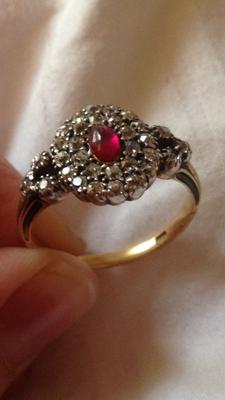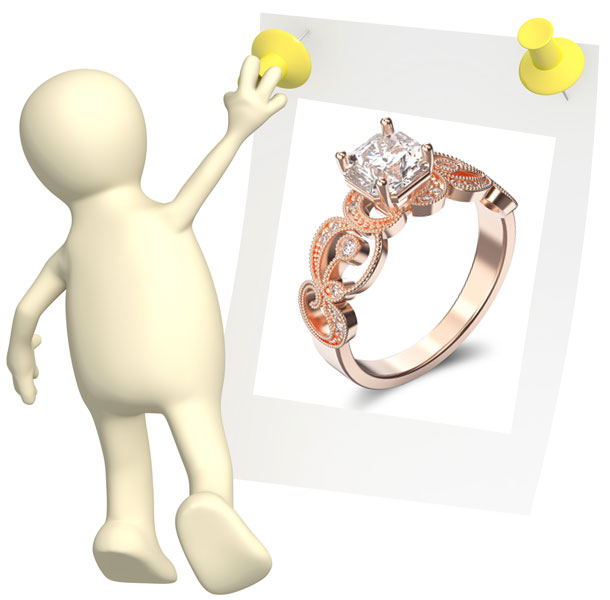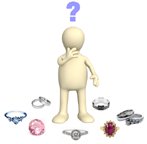Georgian ring? Date and origin
by Mel
(Canberra Aus)

Possible Georgian Ring?
I have attached some photos of a beautiful ring my family bought in Australia. The antique dealer who I bought the ring from said that the ring is Georgian. It has 32 very small unevenly cut diamonds and a ruby in the middle the ruby has uneven gold around it and the diamonds appear to be set in silver. The only marking is a very precise 18 in the box at the back. The ring was sold at $2200Au. I'd love to know more about this ring including a more precise time frame and where it might have come from. Thank you very much.

Hello Mel,
Thank-you so much for sharing such a beautiful ring with us!
Regarding the date and origin of the ring, tracking these specifics can be quite difficult because there is no maker's mark on the ring - but the 18 square hallmark stamp may eventually be able to help you pinpoint the origin and date of the ring. But with the info you provided, there are a few clues that can help to provide a few possible answers about the ring.

Starting with the date of the ring, this could be a Georgian ring, but it could have also been crafted during the early Victorian years. It would be interesting to know why the dealer the ring was purchased from believed the ring was specifically from the Georgian era.
The ring does contain a few key identifying traits of a Georgian or early Victorian ring. These include the silver settings used in the diamonds (a very "Georgian" trait in antique rings from this era), the rough-cut diamonds that look from the picture - although hard to tell - like they could be old mine cut diamonds, the 18 karat gold, the cabochon-like shape of the ruby and the metal crimp work around the ring. The diamond cluster style was quite popular during the Georgian days too - as was the use of ruby gemstones.
The problem with finding out the exact date of the ring is that all of these characteristics are seen too in Victorian rings too, particularly rings that were created in the early Victorian era.
Because of the sophisticated metal work and condition of the ring, style, and the other characteristics mentioned above - I would tentatively date the ring to the turn of the century - the 1800s and possibly up to around the 1850s.
As to the origin of the ring - the ring could be from the United States due to the 18 stamp. In most European countries, a hallmark or fineness stamp is represented with a percentage amount of purity in antique pieces of jewelry....so an 18 karat gold ring would be stamped with a 750 number designation instead of an 18. However, the number 18 to indicate fineness was and is used in the United States.
When it came to marking jewelry, Australia tended to follow the British hallmarking and maker's mark systems and in later years after these laws were enacted in Australia a symbol, and later on a 750 stamp, was used to signify 18 karat gold. But, 18 karat gold was also known in Australia as 18 carat gold - so it is possible that the ring could be from Australia too. A letter after the 18 - a c or k - could have helped to identify more about the origins of the ring.
Unfortunately, hallmark laws were not enacted during this time period - and so it is common to see pieces of Georgian and Victorian jewelry without any stamps at all. It is interesting to note though that even without hallmark/maker's mark laws, it was a common practice in Australia to mark pieces of jewelry with maker's marks throughout the 1700 and 1800s. So, antique jewelry pieces can be found from Australia with maker's marks but no hallmark stamps. This leads me to wonder if it is even more likely that the ring is originally from the United States.
If only the original assay office that stamped the ring with the square 18 could be tracked down, that could help to conclusively identify where the ring was from.
However, I was unable to find the exact source of this stamp. It is interesting because of the shape around it - assay offices frequently had specific shapes that were used around the purity of gold, silver and platinum pieces they identified like hexagons or ovals or squares - and because it just contains the 18 with no ct, c or k after it.
So, if you can track down where this ring was assayed and stamped - you may be able to find out more about its exact origins. But that could take quite a bit of research, and it is possible that you may never find out. (Because, even though I am assuming that the ring was stamped by an assay office, it is possible too that a jeweler could have used a stamp to mark the ring, but you would think in this instance that if a jeweler bothered to stamp the ring with a fineness stamp that the jeweler would have also stamped the ring with a maker's mark).
These are all possibilities, but it is most likely that what you have is a ring made around the 1800s to the 1850s - possibly from the United States.
I hope this info is helpful - and if you ever find out anything more about the ring we would love to hear back from you!
Suzanne Gardner
Everything Wedding Rings
Recommended & Trusted Jewelers
Our Advertisement Policy
Adin Fine Antique Jewelry
Use Code=Everything-Wedding-Rings
For a 5% Discount



















